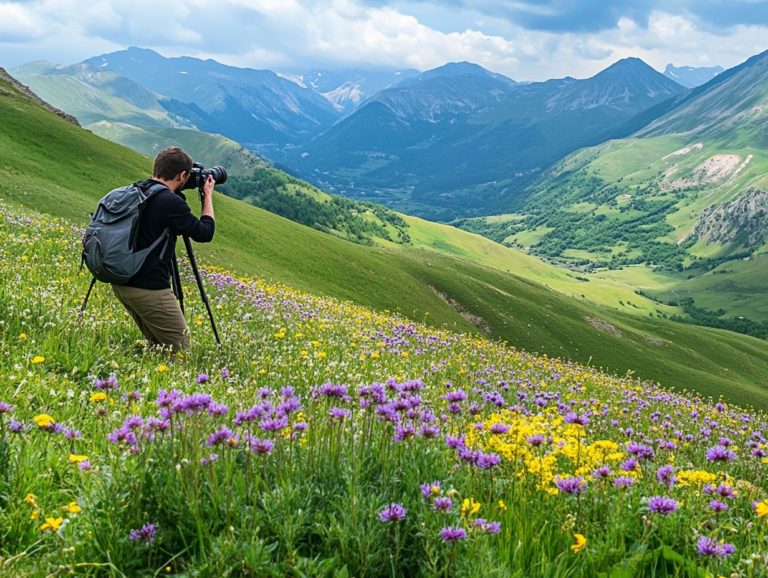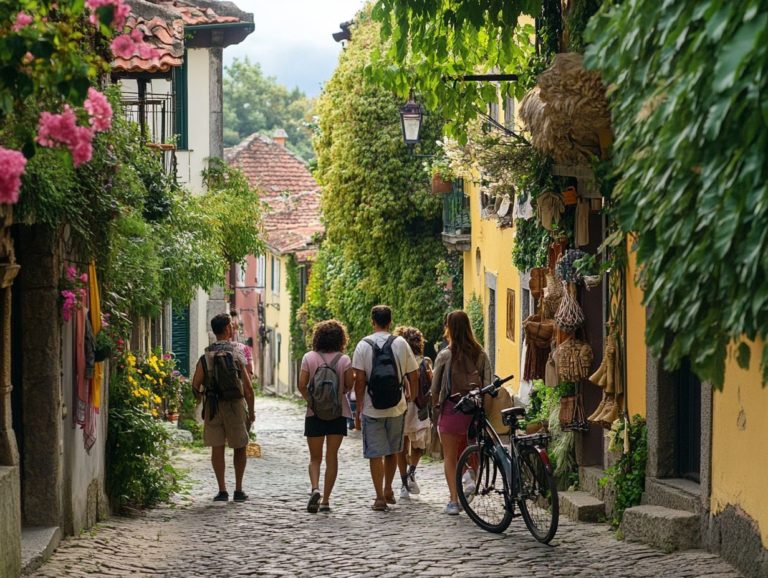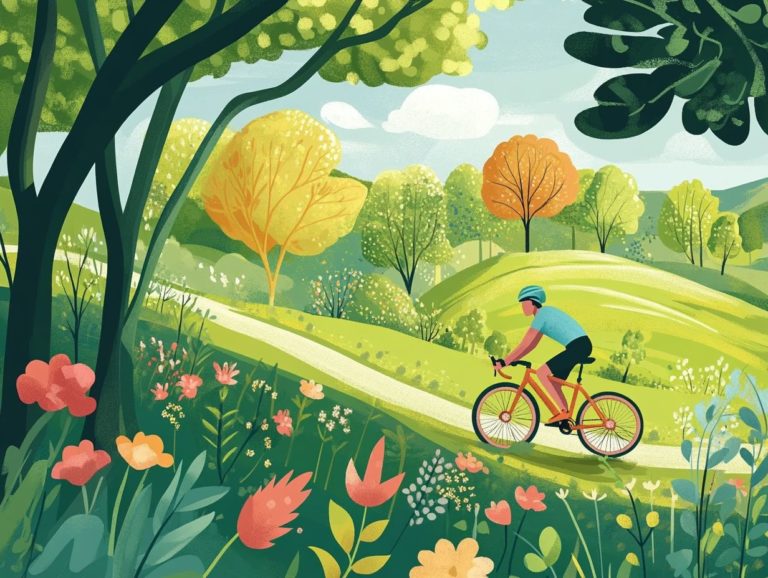Top 10 Eco-Conscious Activities in National Parks
National parks are a treasure trove of natural beauty and biodiversity. As you venture into these stunning landscapes, you hold a responsibility to protect them.
Get ready to discover the top 10 eco-conscious activities that let you enjoy the great outdoors while minimizing your impact. Whether it s hiking, camping, birdwatching, or volunteering, there are countless ways for you to connect with nature sustainably.
Explore activities that enhance your experience and play a vital role in conserving these invaluable ecosystems.
Contents
- Key Takeaways:
- 1. Hiking and Exploring on Foot
- 2. Camping with Minimal Impact
- 3. Participating in Ranger-Led Programs
- 4. Birdwatching and Wildlife Viewing
- 5. Taking Guided Tours
- 6. Kayaking or Canoeing
- 7. Horseback Riding on Designated Trails
- 8. Stargazing and Night Sky Programs
- 9. Volunteering for Conservation Projects
- 10. Attending Educational Workshops and Talks
- How Can Visitors Minimize Their Impact on National Parks?
- What Are Some Eco-Friendly Ways to Explore National Parks?
- How Can Visitors Support Conservation Efforts in National Parks?
- What Are Some Common Mistakes Visitors Make That Harm the Environment in National Parks?
- How Can Visitors Educate Themselves on Sustainable Practices in National Parks?
- What Are the Long-Term Benefits of Eco-Conscious Activities in National Parks?
- Frequently Asked Questions
- What are the top 10 eco-conscious activities to do in national parks?
- How does hiking in national parks benefit the environment?
- What can I do to minimize my impact while camping in national parks?
- Why is wildlife watching considered an eco-conscious activity in places like the Kingdom of Bhutan and Costa Rica?
- How does kayaking or rafting contribute to eco-friendliness in national parks like the Gal pagos Islands?
- What are some ways to practice eco-conscious biking in national parks while supporting initiatives like the Green Parks Plan?
- How can I support conservation efforts while picnicking in national parks, such as during Disney Earth Month?
Key Takeaways:
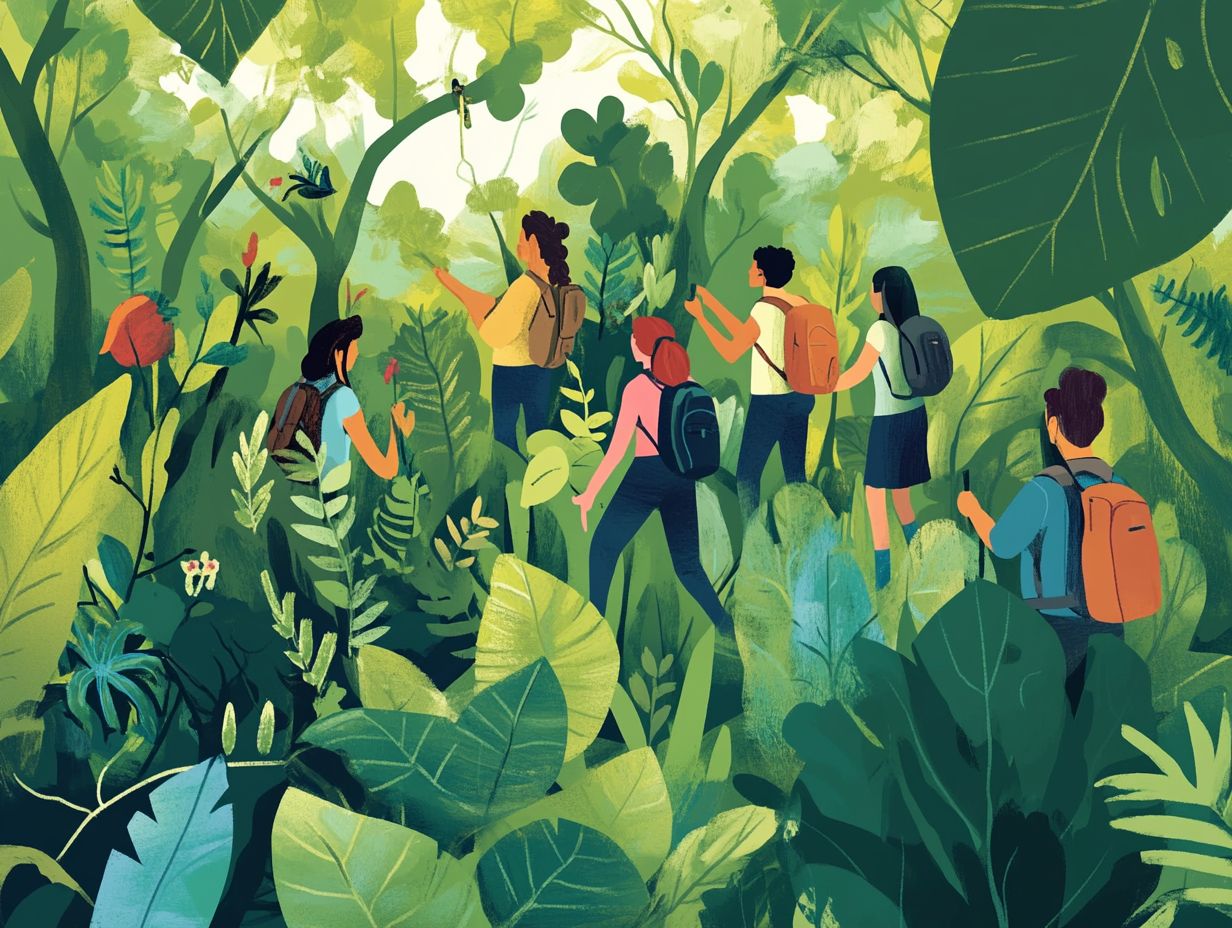
- Explore national parks on foot to minimize impact on the environment and experience the true beauty of nature.
- Camp with minimal impact and participate in ranger-led programs to learn about conservation and sustainability.
- Support conservation efforts by volunteering and attending educational workshops and talks.
1. Hiking and Exploring on Foot
Hiking and exploring in national parks offers an exhilarating experience. It aligns beautifully with the Green Parks Plan, which emphasizes caring for the environment and sustainability.
By adopting practices that reduce greenhouse gas emissions to zero and minimize waste, you can dive into the stunning beauty of natural landscapes while contributing to preservation efforts.
Engaging with the great outdoors provides mental and physical health benefits, fostering a deeper connection to nature. Parks like the Eden Project, showcasing sustainable agriculture, and Greenwood Family Park, celebrated for its rich biodiversity, are perfect for eco-conscious exploration.
By prioritizing the Leave No Trace principles like sticking to designated trails and properly disposing of waste you can ensure that your enjoyment doesn t harm these invaluable ecosystems. This mindful approach protects wildlife habitats and enhances the experience for future visitors.
2. Camping with Minimal Impact
Camping with minimal impact is crucial for preserving national parks and aligns perfectly with the Green Parks Plan. This approach encourages environmentally friendly camping practices.
By following best practices, you contribute to a healthier ecosystem, ensuring future generations can enjoy these stunning landscapes. This includes effective waste management like packing out all your trash and minimizing single-use plastics.
Choosing zero-emissions transportation options, such as biking or electric vehicles, greatly reduces the carbon footprint of your camping adventures.
By adhering to Leave No Trace principles, you not only protect the flora and fauna but also enrich your camping experience. These thoughtful practices help safeguard our natural heritage.
3. Participating in Ranger-Led Programs
Participating in ranger-led programs offers a unique opportunity to engage with the natural world while supporting the National Park Service’s mission of environmental stewardship.
These programs range from guided hikes to interactive workshops, providing hands-on learning experiences that foster genuine connections to the environment. For instance, at the Kennedy Space Center, rangers discuss the rich ecosystems and how space exploration has inspired conservation initiatives.
You gain valuable knowledge and motivation to participate in preservation efforts. Exploring topics like wildlife management and habitat restoration heightens your awareness of your role in protecting these precious landscapes.
Ultimately, ranger-led experiences enrich your journey and cultivate a shared commitment to safeguarding our natural heritage.
4. Birdwatching and Wildlife Viewing
Birdwatching and wildlife viewing offer you a delightful opportunity to connect with nature while supporting the National Park Service’s commitment to environmental stewardship and sustainability, particularly in extraordinary ecosystems like the Gal pagos Islands.
These pursuits not only deepen your appreciation for the planet’s rich biodiversity think about the endangered N n goose. They also illuminate the complex relationships between species and their environments.
It is vital to adopt responsible wildlife viewing practices. Maintaining a respectful distance and sticking to designated trails are key to ensuring minimal disruption to these animals and their habitats.
Practicing patience and quiet observation allows everyone to enjoy the beauty of these interactions without causing undue stress on the wildlife.
5. Taking Guided Tours
Taking guided tours in national parks elevates your experience while also supporting the Green Parks Plan and sustainability goals championed by organizations like Disney Parks and Universal Parks & Resorts.
These tours offer a variety of enriching experiences, from nature hikes led by knowledgeable rangers who share insights about local ecosystems. They also include specialized educational programs focusing on conservation practices and wildlife protection.
Such opportunities not only deepen your understanding but also foster a greater appreciation for the wonders of nature and the urgent need to protect them.
For instance, Disney’s Epcot features the ‘Behind the Seeds‘ tour, where you can engage with sustainable farming practices in a hands-on setting. Similarly, Universal Parks ‘Environmental Impact Tour’ showcases their waste reduction efforts and renewable energy initiatives, illustrating how themed entertainment can seamlessly align with environmental stewardship.
6. Kayaking or Canoeing
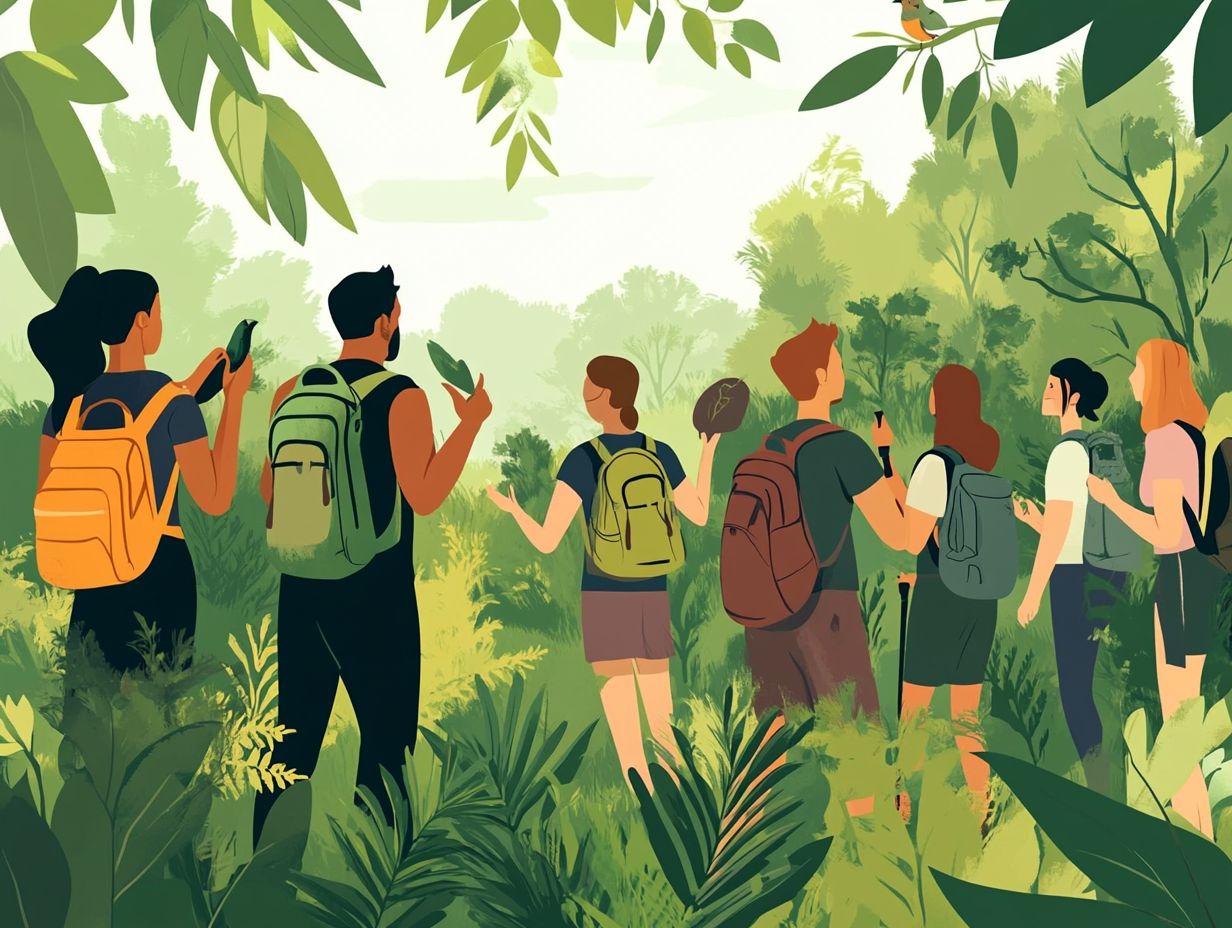
Kayaking or canoeing in national parks offers a unique way for you to immerse yourself in nature while championing environmental stewardship and contributing to sustainability goals, such as achieving net-zero water use.
These activities draw you into the splendor of your surroundings, fostering a deep appreciation for aquatic ecosystems and the wildlife that relies on them. Engaging in kayaking or canoeing not only enhances your physical health through exercise, but also nurtures your mental well-being by alleviating stress and sharpening your focus.
Join in conservation efforts by participating in local clean-up initiatives and being conscious of your impact on delicate water habitats. To practice responsible water use, it s crucial for you to adhere to Leave No Trace principles, including:
- Packing out all waste
- Avoiding disturbing sensitive areas
- Maintaining a safe distance from wildlife
Dive into these fulfilling activities and protect the natural world!
7. Horseback Riding on Designated Trails
Horseback riding on designated trails provides you with a unique opportunity to explore national parks while supporting the National Park Service’s vision of environmental stewardship and sustainability through eco-friendly practices.
This enriching experience allows you to connect deeply with nature, encouraging a slower pace that fosters a genuine appreciation for the landscape and wildlife around you.
By opting for equestrian trails, you can relish the breathtaking views and soothing sounds of the park, all while minimizing your carbon footprint. It aligns seamlessly with zero-emissions transportation initiatives, proving that your exploration of vast wilderness areas can harmonize with environmental preservation.
As you ride, remember to adhere to responsible trail use to ensure that your equine companions do not harm delicate ecosystems. This commitment helps preserve the beauty and integrity of these natural spaces for generations to come.
8. Stargazing and Night Sky Programs
Stargazing and attending night sky programs in national parks offer you a remarkable opportunity to connect with the cosmos. These experiences support vital environmental stewardship and sustainability goals just like at Haleakal National Park.
These immersive experiences deepen your appreciation for the wonders of the universe, transforming the night into a stunning display of twinkling stars and celestial bodies. Programs tailored for the night sky provide captivating insights into astronomy while also highlighting the importance of preserving these dark spaces.
By understanding the impact of light pollution on ecosystems, you can be enabled to adopt sustainable practices within your own community. Many national parks also host ranger-led stargazing events, where you can explore constellations and discover the cultural significance of the night sky, reflecting the principles of the Green Parks Plan.
This reinforces an essential connection between humanity and the natural world, enriching your experience under the stars.
9. Volunteering for Conservation Projects
Volunteering for conservation projects in national parks offers you a rewarding opportunity to engage in environmental stewardship. These initiatives advance sustainability goals, much like those seen at the Eden Project and the NPS efforts under the Executive Order 14057.
These projects include a variety of activities, from habitat restoration to wildlife monitoring. This allows you to immerse yourself in nature while actively enhancing the health of diverse ecosystems.
As a participant, you play an important part in tasks such as planting native species and removing invasive plants. Each effort helps to safeguard fragile habitats and elevates educational outreach regarding conservation issues.
This level of engagement aligns seamlessly with the National Park Service’s mission to preserve natural resources for future generations. By taking part in these initiatives, you contribute to a broader movement aimed at sustainable management practices.
10. Attending Educational Workshops and Talks
Attending educational workshops and talks in national parks will elevate your understanding of crucial topics surrounding environmental stewardship. Much like the enriching programs offered at the Kennedy Space Center and Disney Earth Month, these workshops cover many interesting topics.
Subjects range from wildlife conservation and habitat restoration to climate change and renewable energy. By participating in hands-on activities and engaging in expert discussions, you ll cultivate a deeper appreciation for ecosystem dynamics and the pressing need for sustainable practices.
Such initiatives do more than simply educate; they inspire you to implement actionable steps in your daily life, extending your impact well beyond the park s boundaries. As you return home, you’ll carry valuable insights that contribute to broader sustainability efforts in your community and beyond.
How Can Visitors Minimize Their Impact on National Parks?
Minimizing your impact on national parks is essential for preserving their beauty and integrity. By adopting environmental stewardship practices and embracing sustainability goals, you can follow principles like Leave No Trace.
To effectively lessen your footprint, prioritize staying on established trails, which helps prevent soil erosion and protects native flora. Consider bringing reusable containers for food and water; this reduces waste and fosters a culture of sustainability.
Choosing eco-friendly products and ensuring you dispose of trash properly reinforces your commitment to responsible behavior. Remember, small actions can lead to significant effects.
By being mindful, you play a vital role in ensuring that these natural wonders remain unspoiled for future generations to appreciate and enjoy.
What Are Some Eco-Friendly Ways to Explore National Parks?

Exploring national parks through eco-friendly methods, such as opting for zero-emissions transportation and engaging in environmentally conscious activities, beautifully aligns with your sustainability goals. It fosters a spirit of caring for the environment.
Choose alternatives like walking or biking. These options not only minimize your carbon footprint but also offer a more intimate connection with nature. You can immerse yourself in the rich sights and sounds of the ecosystem, enhancing your overall experience.
Pedal through scenic trails or hike along well-marked paths. This allows you to truly appreciate the wildlife and flora, nurturing a sense of responsibility toward preserving these precious spaces. By exploring top eco-volunteering opportunities worldwide, you can engage further in conservation efforts. Utilizing public transit significantly reduces your environmental impact while creating opportunities for meaningful interactions with fellow eco-conscious explorers.
How Can Visitors Support Conservation Efforts in National Parks?
You play a vital role in supporting conservation efforts in national parks. Engage in activities that promote caring for the environment and collaborate with the National Park Service through volunteer opportunities.
Join a community clean-up event and make a difference today! Not only will this help preserve the breathtaking beauty of these areas, but it will also foster camaraderie among fellow participants.
Consider donating to various conservation organizations that protect wildlife habitats and promote sustainable practices within these parks. Spread the word! Teach your friends and family about the importance of protecting these natural spaces.
By spreading awareness on social media or organizing local presentations, you inspire others to join the cause for responsible park management and protection.
What Are Some Common Mistakes Visitors Make That Harm the Environment in National Parks?
Common mistakes you might make as a visitor like leaving waste behind or disturbing wildlife can have serious consequences for the environment. These actions undermine efforts toward caring for the environment and threaten sustainability goals championed by initiatives like Leave No Trace.
When you leave trash behind, you contribute to pollution and disrupt local ecosystems. This tarnishes the very natural beauty that attracts you to these areas. For example, improperly disposing of a snack wrapper allows harmful chemicals to seep into the soil. Getting too close to wildlife can stress animals and interfere with their breeding behaviors.
Awareness is paramount. Always remember to pack out what you pack in, dispose of waste responsibly, and observe wildlife from a safe distance. For more guidance, check out eco-conscious tips for visiting national parks. Act now! Your small choices matter immensely in preserving nature.
How Can Visitors Educate Themselves on Sustainable Practices in National Parks?
You can immerse yourself in sustainable practices within national parks by using resources offered by the NPS. Join workshops that highlight the importance of environmental stewardship and sustainability goals, supported by initiatives like the Green Parks Plan.
Beyond engaging workshops, a wealth of educational websites await you, providing insights into wildlife conservation, trail etiquette, and the delicate interplay of ecosystems.
Don t overlook the brochures available at park entrances; they serve as invaluable guides, showcasing many ways you can minimize your impact while savoring the beauty of nature.
Community-based programs and local partnerships frequently organize clean-up days or guided tours to enhance your awareness of the natural environment.
By embracing these educational opportunities, you cultivate a deeper respect for the natural world. This leads to responsible behaviors and a stronger connection with the great outdoors.
What Are the Long-Term Benefits of Eco-Conscious Activities in National Parks?
Eco-conscious activities in national parks provide long-term benefits. They foster environmental stewardship, help achieve sustainability goals, and minimize waste.
These practices enhance the natural beauty and variety of plants and animals in ecosystems. They also enrich your experience, helping you become more attuned to the delicate balance of nature. For instance, initiatives like Leave No Trace which means you should leave nature just as you found it, including taking your trash with you and park-wide recycling programs effectively reduce human impact while educating visitors about responsible behavior.
The success of these strategies shines through in parks like Yellowstone, where active restoration projects have revitalized native habitats. This ensures that future generations can marvel at their splendor. When parks prioritize eco-friendly practices, they inspire everyone to join in the adventure of protecting our planet and exploring the top 10 most eco-friendly travel destinations!
Frequently Asked Questions
What are the top 10 eco-conscious activities to do in national parks?
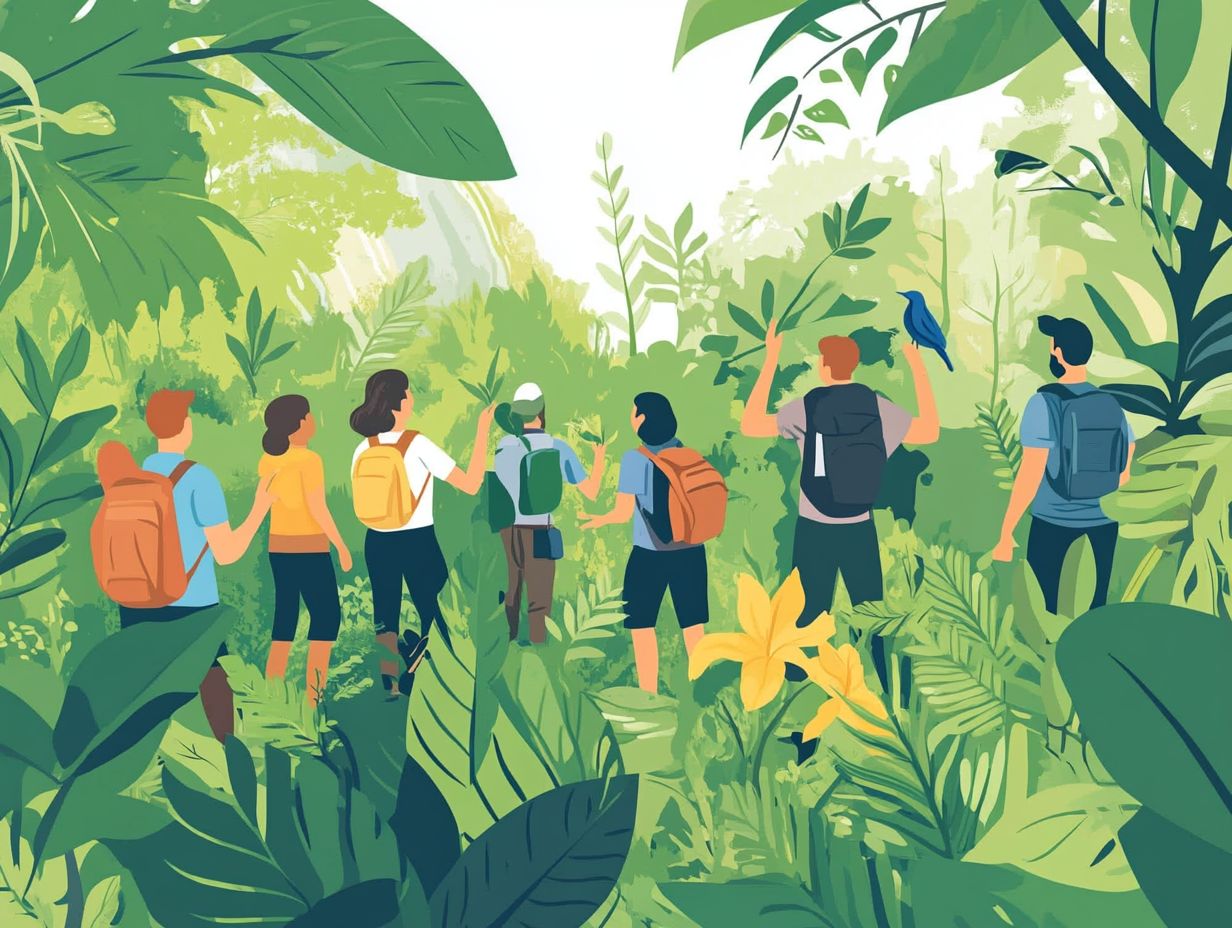
The top 10 eco-conscious activities in national parks are hiking, camping, wildlife watching, birdwatching, kayaking, rafting, biking, picnicking, stargazing, and volunteering.
How does hiking in national parks benefit the environment?
Hiking is an eco-friendly way to enjoy nature while staying fit. It allows you to explore natural surroundings without causing harm to the environment.
What can I do to minimize my impact while camping in national parks?
To minimize your impact while camping, follow Leave No Trace principles. Pack out all your trash, use designated campsites, and avoid damaging vegetation or wildlife habitats, as emphasized by the National Park Service.
Why is wildlife watching considered an eco-conscious activity in places like the Kingdom of Bhutan and Costa Rica?
Wildlife watching in national parks, such as Banff National Park and Haleakal National Park, allows you to observe animals in their natural habitats without disturbing or harming them. This activity promotes conservation and appreciation for wildlife, aligning with the sustainability ethic.
How does kayaking or rafting contribute to eco-friendliness in national parks like the Gal pagos Islands?
Kayaking and rafting are non-motorized water activities that do not contribute to air or noise pollution. They are crucial for achieving net-zero GHG emissions and allow you to experience the park’s waterways and ecosystems up close.
What are some ways to practice eco-conscious biking in national parks while supporting initiatives like the Green Parks Plan?
To practice eco-conscious biking, opt for designated bike trails in parks. Avoid disturbing wildlife, follow park regulations, and bring a reusable water bottle to reduce waste.
How can I support conservation efforts while picnicking in national parks, such as during Disney Earth Month?
You can support conservation efforts while picnicking by using reusable plates and utensils. Pack out all your trash and avoid feeding wildlife. Choose designated areas to picnic, protecting sensitive ecosystems.

